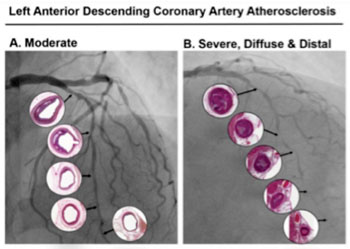Glycated Proteins and Oxidized Lipoproteins but Not Insulin Resistance Linked to CVD Risk
By LabMedica International staff writers
Posted on 23 Jul 2015
Heart disease researchers working with a pig model system identified glycated proteins and oxidized low-density lipoproteins (oxLDL) as biomarkers for cardiovascular disease (CVD) risk but did not find a similar association between CVD risk and insulin resistance.Posted on 23 Jul 2015
Investigators at the University of North Carolina (Chapel Hill, USA) chose to work with pigs, since pigs, like humans, develop coronary artery and aortic atherosclerosis and insulin resistance. In addition, pigs have been used in many studies to define the mechanisms that mediate increased atherosclerosis in diabetes.

Image: Left: depicts moderate heart disease with limited arterial blockages in the heart of a pig. Right: severe disease with several near-total blockages. The two biomarkers (glycated proteins and oxidized LDL) were greatly elevated only in severe disease (Photo courtesy of the University of North Carolina).
In the current study, severity of coronary atherosclerosis was determined for 37 adult pigs (Sus scrofa) that had been fed a high fat diet that also contained high NaCl (56% above recommended levels) for one year.
Results published in the July 6, 2015, online edition of the journal PLOS One revealed that 20 pigs developed severe and diffuse distal coronary artery while the other 17 pigs had substantially less coronary artery atherosclerosis. All 37 pigs had blood pressure measurements in a range that would be considered hypertensive in humans and developed elevations in total, LDL, and HDL cholesterol, weight gain, increased backfat, and increased insulin resistance without overt diabetes. Five additional pigs fed regular pig chow also developed increased insulin resistance but essentially no change in the other variables and little to no detectible coronary atherosclerosis.
The 20 high fat/high NaCl diet-fed pigs with severe and diffuse distal coronary artery atherosclerosis had substantially greater increases in oxidized LDL and fructosamine consistent with increased protein glycation. Insulin resistance was not associated with atherosclerosis severity.
"If these correlations were also found in insulin resistant humans, then we would want to do everything we could to treat them because they would be at a very high risk of developing severe cardiovascular disease," said first author Dr. Timothy Nichols, professor of medicine and pathology at the University of North Carolina.
Related Links:
University of North Carolina












